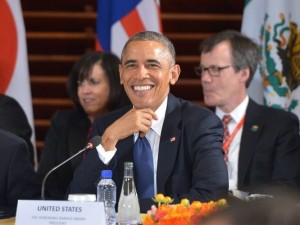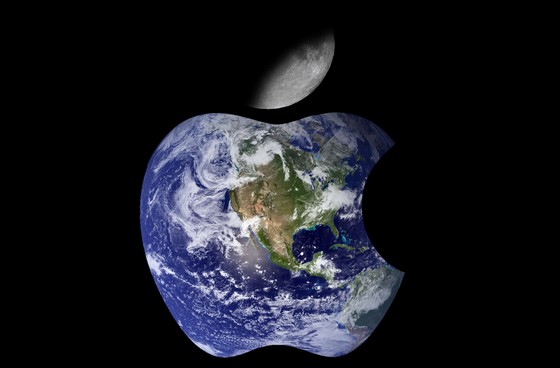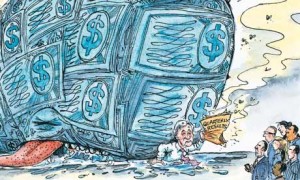What’s th e biggest news in China recently? The answer is APEC. Yes, APEC is now taken place in Beijing, gathering leaders from different countries to make important decisions in the pursuit of creating a better business community around the world. There is one highlight on today’s news releases that catches my eyes: Obama touts new China visa deal as way to create U.S. jobs. To me such decision will benefit both China and US because it will help pursue a sustainable development in the business community.
e biggest news in China recently? The answer is APEC. Yes, APEC is now taken place in Beijing, gathering leaders from different countries to make important decisions in the pursuit of creating a better business community around the world. There is one highlight on today’s news releases that catches my eyes: Obama touts new China visa deal as way to create U.S. jobs. To me such decision will benefit both China and US because it will help pursue a sustainable development in the business community.
According to the triple bottom line, extending Chinese citizens’ student, business and tourist visas will fulfill social, financial and environmental portions of the three-factor diagram. Below are my analyses.
Socially, such move will help Chinese citizens build up a sense of belonging in US. They will have a longer time experiencing in US, sharing US culture with local people. At the same time, US will build more culture diversity. Extending the visa will benefit both US and China and not to exploit any single one of them.
Financially, extending visas will help attract more students, more tourists and more knowledgeable people to come to US. A White House statement said by 2021, Chinese travelers to the United States will contribute nearly $85 billion a year to the economy and support up to 440,000 jobs.
Environmentally, I haven’t come up with any potential benefits brought by extending Chinese citizens’ visas. However, I truly believe such action is a great progress made by both leaders of US and China. Such sustainable decision will eventually improve economic ties between the two countries, bringing the relationship between theses two countries to the next level.
References:
Picture1: <http://www.usatoday.com/story/news/world/2014/11/10/apec-beijing-obama/18786007/>.
Picture2: <http://www.powerhousegrowers.com/wp-content/uploads/2013/10/the-triple-bottom-line.jpg>.



 mplemented in society even if the United Nations was fully funded. United Nations could only relief the pain transiently by giving out money. Sitting high up on the social hierarchy, UN outlooks the world in a much more general point of view. Who thinks UN would care or even know
mplemented in society even if the United Nations was fully funded. United Nations could only relief the pain transiently by giving out money. Sitting high up on the social hierarchy, UN outlooks the world in a much more general point of view. Who thinks UN would care or even know  There used to be a stereotype sticking in my mind: an entrepreneur is someone who comes up with the groundbreaking idea and eventually put that spark of mind into practice. However, when I recently perused a
There used to be a stereotype sticking in my mind: an entrepreneur is someone who comes up with the groundbreaking idea and eventually put that spark of mind into practice. However, when I recently perused a 
 Recently, my classmate
Recently, my classmate  For years, Lululemon has covered their shopping bags with quotes and expressions from the Dalai Lama Center’s Five Domains of Hear-Mind Well-Being. Such action not only defines characters for Lululemon, but also expands Dalai Lama’s core idea of mindfulness and a non-judgmental awareness on the presence. Rationally speaking, I believe that Lululemon’s partnership with Dalai Lama helps raise awareness of developing compassionate minds, which at the end empowering healthier communities. Such action simultaneously advances social conditions in our community.
For years, Lululemon has covered their shopping bags with quotes and expressions from the Dalai Lama Center’s Five Domains of Hear-Mind Well-Being. Such action not only defines characters for Lululemon, but also expands Dalai Lama’s core idea of mindfulness and a non-judgmental awareness on the presence. Rationally speaking, I believe that Lululemon’s partnership with Dalai Lama helps raise awareness of developing compassionate minds, which at the end empowering healthier communities. Such action simultaneously advances social conditions in our community.
 Recently, I have perused
Recently, I have perused 
 Coincidentally, “Oilsands pipelines and other natural resource projects aren’t the only ambitious initiatives being stymied in B.C. due to deepening uncertainty caused by unresolved aboriginal land claims,” stated in another
Coincidentally, “Oilsands pipelines and other natural resource projects aren’t the only ambitious initiatives being stymied in B.C. due to deepening uncertainty caused by unresolved aboriginal land claims,” stated in another 
 In class 2 Marketing Meeting Accounting, the idea that all U.S manufactures are paying a huge amount of money for health-care is introduced by
In class 2 Marketing Meeting Accounting, the idea that all U.S manufactures are paying a huge amount of money for health-care is introduced by 
Recent Comments